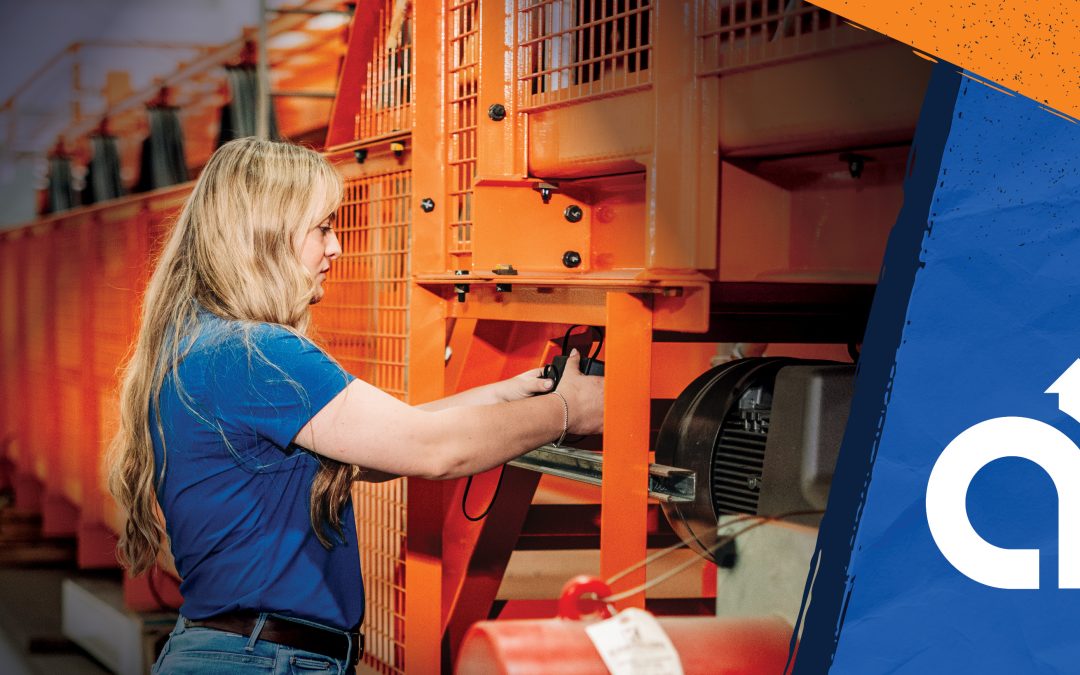Manufacturing isn’t just about gears turning or metal clanging — it’s about people who design, build, and keep the world moving. And more women than ever are stepping into those spaces, running cranes, programming robots, and leading teams.
The story of women in manufacturing is long and textured. During the Industrial Revolution, women worked in mills and factories, performing repetitive but critical tasks under grueling conditions. In World War II, “Rosie the Riveter” became an icon of women stepping into industrial jobs — proving that when necessity called, women could power heavy industry just as well as men.
Today, women are no longer just filling gaps in the workforce. They are choosing manufacturing as a career path, pursuing engineering degrees, earning crane licenses, leading production teams, and driving innovation in automation, sustainability, and materials science.
From History to Modern Day
The path from Rosie the Riveter to today’s plant floor wasn’t a straight line. After the war, many women were pushed back out of factories to make room for returning soldiers. What has changed now is permanence: women aren’t just temporarily present — they are reshaping the sector from within.
Modern trailblazers are everywhere. In Ireland, Kate Fahey became one of the world’s youngest licensed crane operators at just 18, trading an office role for the cab of a crane high above a construction site. In British Columbia, Sandra Allard faced resistance before earning her tower crane ticket and now services and maintains cranes, proving that technical mastery can break down old perceptions. On the U.S. West Coast — at the ports of Long Beach and Los Angeles — Maria Adame serves as both a longshore crane operator and one of the few female crane instructors, training others to manage container operations with precision.
Each of these stories underscores the same truth: when women step into roles that were once closed to them, they don’t just participate — they lead.
Shaping the Future
Manufacturing today is about far more than manual labor. It is digital, automated, and increasingly sustainable — and women are helping to lead those shifts. In materials science, innovators like Veena Sahajwalla are pushing steelmaking toward new models — transforming waste tyres, rubber, and plastics into viable feedstocks, helping show how manufacturing can evolve to be more sustainable and economically viable. In management and mentorship, leaders like Karina Rosales are making space for others, pairing technical expertise with advocacy for equity and inclusion. These contributions aren’t side notes or token gestures — they are central to how the industry is evolving and to the promise of its future.
More Than Representation
Representation matters, but progress isn’t just about getting women through the door. It’s about building workplaces where they can thrive, advance, and shape decisions. Women bring unique insights into safety, ergonomics, team culture, and process improvement — changes that benefit everyone.
Organizations with gender-diverse leadership are better equipped to adapt to change and respond to challenges. When team culture reflects gender diversity, employee retention and engagement rise. And when more girls see women in these roles, the talent pipeline strengthens.
Looking Ahead
Manufacturing is standing at a turning point. As automation, robotics, and AI transform the industry, it needs a workforce that is adaptable, creative, and collaborative. Women are already proving that they are not just ready to meet that moment — they are driving it forward.
At American Crane, we’re proud to be part of this transformation — building innovation into every lift while empowering people to grow, lead, and make a difference. The next era of manufacturing won’t be built by tradition alone; it will be shaped by fresh ideas and diverse perspectives. If you’re ready to help move the industry forward, we invite you to join our team and be part of what’s next in American manufacturing.


